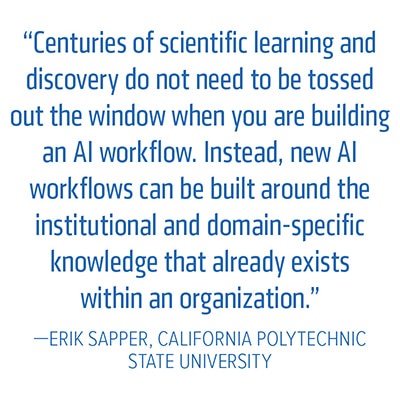By Cynthia Challener, CoatingsTech Contributing Writer
Artificial intelligence (AI) and machine learning (ML) are ideal tools for accelerating product development, particularly in technical fields such as coatings. The application of design-of-experiment approaches and widespread use of advanced statistical analyses already enable coating formulators to better optimize product characteristics while meeting growing regulatory and sustainability requirements.
Using AI and ML tactics and strategies takes formulation science a step further, allowing the incorporation of a much greater range of data into the decision-making process.
Artificial intelligence can be applied to any synthesis or formulation challenge in many ways, according to Erik Sapper, assistant professor in the Western Coatings Technology Center and the Department of Chemistry and Biochemistry at California Polytechnic State University.
For coatings development, machine learning models can be used to predict resin or formulation performance before any material is physically made in the laboratory. In addition, clustering and classification algorithms can look for trends or patterns in existing data, identifying new heuristics or rules of thumb that can be leveraged in later experiments.
“Eventually, artificial intelligence and machine learning workflows will allow users to design new resins and formulations by entering the end-use properties they desire, with advanced algorithms recommending starting point formulations or resin recipes,” Sapper says.
He adds that this type of process has already been demonstrated for many resin and formulation types, and will eventually be the standard industry approach to performing coatings research and development.
Modern artificial intelligence and machine learning algorithms learn from data and look for patterns, just like humans do, Sapper says. “They can learn from both data delivered in large sets and data inserted in drop-by-drop mode, just as researchers do when they run a new batch in the lab, observe and analyze the data, and adjust their approach to the problem they are trying to solve,” he explains.
 In addition, AI and ML models are like people: they improve with time, use, and after being “fed” new data. Because of these characteristics, integrating AI-enabled digital design and discovery tools into existing empirical workflows is a natural fit if it is done with care and concern for the scientist user of these tools.
In addition, AI and ML models are like people: they improve with time, use, and after being “fed” new data. Because of these characteristics, integrating AI-enabled digital design and discovery tools into existing empirical workflows is a natural fit if it is done with care and concern for the scientist user of these tools.
“All members of the formulating team should feel as if their work is amplified or accelerated with the addition of AI tools,” Sapper says.
Machine learning models can also make use of existing chemical or physical models. “Centuries of scientific learning and discovery do not need to be tossed out the window when you are building an AI workflow,” Sapper says. “Instead, new AI workflows can be built around the institutional and domain-specific knowledge that already exists within an organization.”
At the same time, using artificial intelligence and machine learning for in-silico (computerized simulation) synthesis and formulation to predict resin and formulation properties before trial-and-error experimentation occurs in the laboratory also enhances sustainability.
“With the right data and algorithms in place, experimenters and formulators can ‘feel out’ a design space and make an informed decision about further expenditure of material resources and people hours towards making novel proposed materials a physical reality,” Sapper explains. “Essentially, the guess-and-check phase of research is moved out of the laboratory and into digitized and interactive modeling platforms.”
The predictive capabilities also improve the more these systems learn and grow, so in-silico prediction and optimization becomes more advanced.
“Ultimately, entire formulation-design spaces will be explorable in a computational environment, without having to formulate a single batch,” Sapper says. “Testing real resins and formulation for specification performance will always need to be done in the physical realm, but a great deal of material design will be moving out of the laboratory and into computational domains as these artificial intelligence tools evolve and establish themselves in our current R&D workflows.”
There are, of course, hurdles to overcome before that level of adoption can be achieved. According to Sapper, the challenges all generally revolve around the data—how it is structured, its age, who controls it, etc. “These concerns are present regardless of material focus or size of an organization,” he says.
With data structure, for instance, companies struggle with spending time getting the right ones in place versus getting started using existing data in its existing format.
Sapper recommends that companies gather input from multiple teams and departments within the organization to ensure that any long-term database structures are usable and amenable to new data and new materials, from new additive chemistries to new monomers and reaction conditions.
They do, however, need to demonstrate quick wins in applying AI to existing problems to build confidence. Generally, says Sapper, this means data structures and database implementations are often bespoke efforts, designed around the well-defined problem that is being addressed.
Choosing the right data and who has access to it is also important. Not all existing or legacy data needs to be digitized and fed into an AI tool, according to Sapper. Old data was not collected with digitization in mind, and so may be difficult (or even impossible) to parse it into new data structures.
There needs to be a balance between entering old data and generating fresh data through new experiments and formulation efforts. Possible users of that data include technical directors, researchers, marketing teams, and a host of others, and artificial intelligence and machine learning tools should be designed with those users in mind.
Sapper also warns of the need to be wary of institutional bias creeping in when only certain users are allowed to make changes to underlying predictive algorithms.
“Computer models only do what they are told to do,” Sapper says. “Human programmers can unwittingly bias models during the model building and training process if they are not careful of bias or are not being asked questions along the way.” The best way to avoid this issue is to make the development process highly visible to stakeholders across the organization.
For companies looking to leverage artificial intelligence and machine learning to enhance product development but feeling overwhelmed by the challenges presented by starting such a program, Sapper suggests assembling a diverse team that includes technical leadership, executives, program managers, subject matter experts, younger scientists, and IT personnel and have it aim for a “minimum viable product” to demonstrate an early win that can be used to gain traction within the organization.
Once support for the program is available, it will be easier to more effectively tackle the larger challenges. He also says companies must realize that successfully implementing AI into an R&D effort is an ongoing process, a total R&D lifestyle change, and not a one-off project.
In addition, artificial intelligence is a field that is constantly growing and evolving. It is important, therefore, to adopt a mindset of using AI in R&D workflows for years to come and expect to make changes along the way.
Dow Polyurethanes is one of those companies already traveling down the digitalization path. Its Predictive Intelligence capability for product development, which was created in collaboration with Microsoft, is part of a broader digitalization initiative.
The business recently received a FutureEdge 50 Award in recognition of use of this breakthrough technology, which combines Dow’s material science expertise with Microsoft’s AI and ML experience speeding up the two- to three-month-long product development process for polyurethane formulations by 200,000x, reducing the discovery phase to just 30 seconds, according to Alan Robinson, North America commercial vice president at Dow Polyurethanes.
“We’re challenging the way we work and disrupting our own end-to-end innovation cycle with the customer experience in mind to accelerate customers and markets innovation with a better use of science and digital tools to solve tomorrow’s world challenges,” Robinson says. “This is an important milestone within Dow’s broader digitalization vision, with more initiatives to be unveiled soon.”
Dow’s approach of leveraging its coatings expertise in conjunction with artificial intelligence and machine learning is the key to success, according to Sapper. He stresses that companies must view AI as a means for empowering, expediting, augmenting, and amplifying human creativity and effort, not replacing it.
“The term intelligence amplification (IA) was coined in the early days of cybernetics research,” Sapper explains. “We need to embrace this perspective of working with or alongside, and not against, computers, databases, robotics, and automated science.”
Sapper says he realizes that all these ideas might sound futuristic and perhaps a little too close to being pulled from an Isaac Asimov story. “The fact is the future is already here!” he concludes. “Our ability to continue innovation in the field of coating binder development will be fueled by AI-enabled R&D workflows.”
CoatingsTech August 2021 | vol. 18, no. 8
